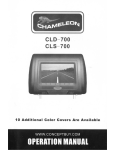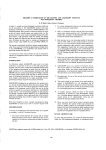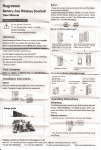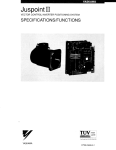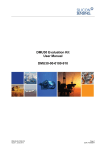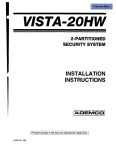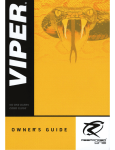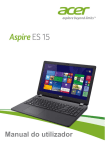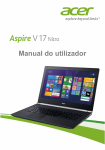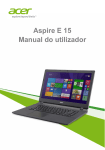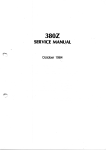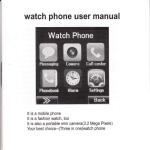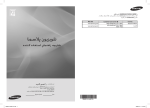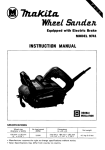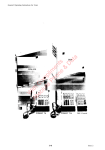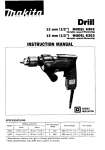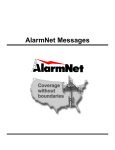Download Model 7620ULF Cabinet Mounted Subscriber Radio
Transcript
a raDEMCq INSTALLATION INSTRUCTIONS PRINCIPAL CHANGES-IN THIS ISSUE ARE INDICATED BY MARGIN LINES GENERAL INFORMATION The No. 7620ULF is a self-contained, microprocessorbased, RF alarm communication system consisting of the No.7620ADV2 Remote Subscriber Equipment (transmitter, transmitter Interface). a power supply and battery packaged in a metal cabinet, and is functionally comparable to a digital communicator in a system connected to a Central Monitoring Station by telephone line. The No. 7620ULF is primarily intended for use with a Fire Alarm System (such as Fire-Lite MS4812). but serves equally well with Burglary Systems. This document provides installation and wiring information for the No. 7620ULF Cabinet Mounted Subscriber Radio. For information regarding the system description, operating instructions, and %lectrical specifications, refer to the No. 7620ADV2 Remote Subscriber Equipment Installation Instructions (P9916-lVl), which are included with the No.7620ULF. SELECTING A SITE Before proceeding with the installation procedures, it is necessary that the installer first verify that the prospective site is suitable for radio communication with the Master Station network. This is accomplished by using the FAST mode of the No. 7920SE, or with the Ademco No. 7915 Field Alarm Signal Tester (FAST). The FAST Tool is a remote field strength indicator that receives transmissions from the network Master Stations. Refer to the No. 7920SE or No. 7915 operating instructions for information regarding FAST mode usage. IMPORTANn The No. 7620ULF cannot be mounted’.outdoors. lf it is necessary to mount the antenna outside, follow the procedures provided on this page for mounting antennas away from the cabinet. When mounting the antenna, avoid obstructions such as metal ducts, pipes, foil backed insulation, etc. as these will adversely affect transmission. MOUNTING THE ANTENNA The antenna (No. 7625) can be mounted either remotely, or directly to the cabinet, and either indoors or outdoors. In the event that reliable communication cannot be achieved, optional Nos. 7625~3db. 7674 or 7674-13 antennas may be used. Note: The No. 7622CDM Transmitter must be installed before mounting the antenna. Refer to the procedures described in the MOUNTING lHE 7622CDM TRANSMmER section. Mounting the 7625 or 76253db Antenna Directly to the Cabinet: 1. Find the best antenna location by using the FAST Tool. 2. Mount the cabiiet using the procedures described in the MOUNTING THE 762OULF CABINETsection. 3. Connect the antenna to the cabinet antenna connector. Mountlng the 7625 or 7625-3db Antenna Away from the Cabinet: 1. Find the best antenna location by using the FAST Tool. 2. Secure the Ademco No. 7670 Subscriber Antenna Bracket to the mounting surface using #lO screws. Connect the antenna to the bracket connector. 3. Connect the antenna cable (50 ohm coaxial cable) to the bracket connector and to the cabinet antenna connector. To avoid signal loss through attenuation, cable lengths should be 50 feet or less. Use only the cables listed in Table 1. Tape antenna connections to seal against moisture. Using the Optional 7674 or 7674-13 Antenna: In the event that an acceptable signal strength cannot be achieved using the No. 7625 antenna, as determined by the FAST Tool, the optional No. 7674 or No. 7674-13 antenna may be installed outdoors in a suitable location. Each of these antennas has directional characteristics, and must be aimed in the direction which provides the strongest signal. Once this direction has been determined, using the FAST Tool, the antenna should be permanently mounted in precisely the same position. Connect the antenna to the transmitter using the shortest of the available fifty ohm coaxial cables which will reach. Tape all connections with a good quality insulating tape. The No. 7670 BRACKET is not Table 1. Ademco Part No. Cable Lengths 7626-5 5 feet 7626-l 2 12 feet 7626~25LL 25 feet 1 7626-TLL y 1 50 feet lmportantl To ensure the integrity of the security system, use only the caMes available from ADEMCO. 00 NOT assemble our own extension cables. DIRECT MOUNT TO CABINET MOUNTING v- -*-= h-4 I Crul AWAY Fnvm CABINET MOUNTING No. 7674 ANTENNA N4233V2 71’91 MOUNTING THE No. 762OULF CABINET The No. 7620ULF cabinet should be mounted indoors. 8nd in an area where lt will be undisturbed. To facilitate system testing, the cabinet should also be located in an easily sccessible area Cabinet Mountlng and Wiring PrOCedUrOS: 1. Mount the transformer plate (packed separately) to the two standoffs using 110 screws. 2. Using the template provided, locate and drill pilot holes for the four mounting screws. 3. Install the two top comer screws, but leave their heads slightly protruding from the mounting surface. Slip the c&net keyslot holes over the screws. 4. Install the bottom two oomer screws, 8nd tighten all screws securely. 5. Connect the antenna (or antenna cable if antenna is mounted remotely) to the cabinet antenna connector. 6. Connect the Alarm Control Panel to the No. 7620ULF by using either shielded or twisted, 22AWG multiconductor cable. Route the wiring through the cabinet knockout hole and connect the wires to cabinet TBl terminals as shown in the Summary of Connections Diagram. IMPORTANT! Do not exceed wire lengths of 125 feet. Use oopper wire, not steel wire. 7. Place the batery in the bwer left comer of the cabinet. 8. Route the AC input wires through the cabinet knockout hole and connect to the two fbating black transformer wires. DO NOT CONNECT TO POWER SOURCE AT THIS TIME! CAUTION! To prevent dlslodglng from sheetrock, the No. 7620ULF Should be mounted such that at le88t the two 8CrSW8 On the door hing8 side Of the cebinet 8re Secured t0 8 WSII siiud. I B SA : APPROVED BY THE NEW YORK CflY BOARD OF STANDARDS AND APPEAL3 UNDER CALENDAR NUMBER 86189-SA. POWERING THE SYSTEM The No. 7620ULF requires a non-switchable, continuous, 12OVAC. 6OHz input voltage. 24 hour power source, using the insulated wire splices provided. - SPECIAL 7 WARNING! 1. Verify that all internal cabinet connedions are complete. and be 8uro that the trrnsformer Input connectIon 8re 8deqUStely ln8UlSted to prevent l lectrlcsl Shock. 2. Plug the battery oable into the No. 468CH Power Suppfy recept8cle. 3. Connect the transformer input wires to a 12OVAC. 60Ht ’ WHEN ~SR POWER ~v”E” IS 13 A~-~LISU, APPLIED, THE TRANSFORMER WIRES IRES CARRY HIGH VOLTAGE (12OVAC) WHICH CAN bN CAUSE SEVERE INJURY OR DEATH. BE .-. i.“P -a SURE TO INSULATE ‘NSULATE THIS CONNECTION i:. TO PREVENT ELECTRICAL ...-ADEQUATELY, SHOCK TO PERSONNEL. RSONNEL. U.L. INSTALLATlON ff the No. 7620ULF Is used for Fire Service, note the followlng requirements: 1) Channel inputs must be connected to the ‘Alarm’ 8nd ‘System Trouble’ outputs of the Listed Fire Control Panel. See Note 1. 2) The No. 762OULF must be close-nipple connected to the Liied Fire Control Panel. 3) ff a digital wmmunic8tor is installed in the Fire Control Panel, an outdoor and/or long antenna cable length may be used if: a. The No. 7620ULF is programmed to monitor the antenna drr%it at least once every 180 seconds, and b. The ‘XMIT OK’ output is connected to the ‘Radio Fail’ trigger input of the Listed Fire Control Panel. See Note 2. INSTRUCTIONS - unit enclosure must be protected by 8 Listed Passive Infrared Detector which is connected to an input zone programmed for interior burglary protection. The antenna must be installed indoors and, if an antenna cable is used. it must be no longer than 12 feet. 4) For Grade A service, the Listed Burglar Alarm Control Panel must have an integral communicator or a Listed communicator must be installed. The No. 659EN line Monitor output must be connected to an input channel of the No. 762OULF. The ‘XMlT OK’ output must be connected to an initiating zone of the Listed Control Panel or communicator, and this zone must be programmed for ‘trouble on short circuit’. Note 7: The No. 7620ULF has been UL Listed for use with any Listed NFPA71 control panel, provided that the AC Fail/AC Brown-out supervision of the control panel is connected to a zone input of the 7620ULF. Note 2: lf a digital communicator is not installed in the control panel, and a remote mounting of either the antenna and/or the 7622CDM transmitter is desired, then supervision of the interconnecting wires between the 7621AD and the 7622CDM and/or between the 7622CDM and the antenna is required by connecting the Radio Fault input (pin 22 of the 7621AD) to an appropriate local annunciating means. SBrViCB, If the No. 7620ULF I8 Usad for BUrglSry note the following requirements: 1) Zone inputs must be connected to dry contact outputs of a listed Burglar Alarm Control Panel. 2) The No. 7620ULF must be dose-nipple connected to the listed Control Panel. 3) For G&e B or C servios. the antenna, antenna cable and 2 :-. MOuNnmnE762zCm-mm SPECIFICATIONS 1. Removethesauedbmak+fftahhomhottomawerof theT~mlttorbybendingItrp~dormafowtimes. 2. Connect wires from TE2 to the Tmnamftter a8 folbws: tB2 TRANSMITTER 7 (vblet) 2 @-urn 6 (+lZVDC) 8 mYI 9 (white) 5 (modulation Input) lO@ladc) 4 we mJu 3 (monitor output) 11 m&w 3. From the hardware kit provided, place the foam pnds on the base of the a&net, beneath the Transmluer, near the top of the cabinet. Place an insufating washer on top ol each of the two mountfng standoffs and carefully position the Transmitter on the standoffs and foam pads, aligning the holes in the bottom cover with the standoffs. Secure the Transmitter with the screws provided - two 3/8’ bng screws into the standoffs. and one 1R bng screw into the top of the Tmnsmitter. Spedkdbm for the No.7620ULF are kfentical to those listed In the No. 7620ADV2 Installation Instructions (included wlth the 762OULF). with the l ddttiin of the phyalcal size of the No. 7620ULF cabinet. whbh lx Cabinet DImmalone: lr L x lZ W x 4.0. Wt: 16 bs. PANEL Pfogrummlng Note: When programming the PROM. program zone 6 for inverted operation, since terminal 9 (AC SUPV) is I normally high. SUMMARY OF CONNECTIONS DIAGRAM 3 Regular maintenance and inspection (at least annually) by the installer and frequent testing by the user are vital to continuous satisfactory operation of any alarm system. The installer should assume the responsibility of developing and offering a regular maintenance progrti to the user as well as acquainting the user with the proper operation and limitations of the alann system and its component parts. Recommendations must be included for a specific program of frequent testing (at least weekly) to insure the system’s proper operation at all times. FEDERAL COMMUNICATIONS COMMISSION .-. (FCC) STATEMENT This equipment has been tested to FCC requirements and has been found acceptable for use. The FCC requires the following statement for your information: This equipment generates and uses radio frequency energy and if not installed and used properly, that is, in strict accordance with the manufacturefs instructions, may cause interference to radio and television reception. It has been type tested and found to comply with the limits for a Class B computing device in accordance with the specifications in Part 15 of FCC Rules, which are designed to provide reasonable protection against such interference in a residential installation. However, there is no guarantee that interference will not occur in a particular installation. ff this equipment does cause interference to radio or television reception. which can be determined by turning the equipment off and on, the user is encouraged to try to coned the interference by one or more of the following measures: 9 lf using an indoor antenna, have a quality outdoor antenna installed. Reorient the receiving antenna until interference is reduced or eliminated. Move the receiver away from the transmitter interface. Move the antenna leads away from any wire runs to the transmitter. Plug the transmitter’s power source into a different outlet so that the transmitter and the receiver are on different branch circuits. If necessary, the user should consult the dealer or an experienced radio/television technician for additional suggestions. The user or installer may find the following booklet prepared by the Federal Communications Commission helpful: ‘Interference Handbook’ This booklet is available from the U.S. Government Printing Office, Washington, DC 20402. under Stock No. 004-OOOl l l l 00450-7. The user shall not make any changes or modifications to the equipment unless authorized by the installation fnstructions or User’s Manual. Unauthorized changes or modifications could void the user’s authority to operate the equipment. LIMITED .n WARRANTY Alarm Device Manufacturing Company, a Division of Pittway Corporation, and its divisions, subsidiaries and affiliates (Seller). 165 Eileen Way. Syosset. New York 11791, warrants its products to be in conformance with its own plans and specifications and to be free from defects in materiak and workmanship under normal use and service for 16 months from the date stamp control on the product or, for products not having an Ademco date stamp, for 12 months from date of original purchase unless the installation instructions or catalog sets forth a shorter period, in which case the shorter period shall apply. Seller’s obligation shall be limited to repairing or replacing, at its option, free of charge for materials or labor, any part which is proved not in compliance with Seller’s -specifications or proves defective in materials or workmanship under normal use and service. Seller shall have no obligation under this Limited Warranty or othemise if the product is altered or improperly repaired or serviced by anyone other than Ademco iactory setvice. For warranty service, return product transportation prepaid, to Ademco Factory Service, 165 Eileen Way, Syosset, New York 11791. THERE ARE NO WARRANTIES. EXPRESS OR IMPLIED, OF MERCHANTABILlIY. OR FlTNESS FOR A PARTICULAR PURPOSE OR OTHERWISE. WHICH EXTEND BEYOND THE DESCRIPTION ON THE FACE HEREOF. IN NO CASE SHALL SELLER BE LIABLE TO ANYONE FOR ANY CONSEOUENTlAL OR INCIDENTAL DAMAGES FOR BREACH OF THIS OR ANY OTHER WARRANTY, EXPRESS OR IMPLIED. OR UPON ANY OTHER BASIS OF LlABlLfTY WHATSOEVER, EVEN IF THE LOSS OR DAMAGE Ls CAUSED BY THE SELLER’S OWN NEGLIGENCE OR FAULT. Seller does not represent that its product may not be compromised or circumvented; that the product will prevent any personal injury or property loss by burglary, robbery, fire or otherwise; or that the product will in all cases provide adequate warning or protection. Buyer understands that a properly installed and maintained alarm may only reduce the risk of a burglary, robbery or fire without warning, but it is not insurance or a guarantee that such will not occur or that there will be no personal injury or property loss as a result. CONSEOUENTLY. SELLER SHALL HAVE NO LlABlLflY FOR ANY PERSONAL INJURY. PROPERTY DAMAGE OR OTHER LOSS BASED ON A CLAIM THE PRODUCT FAILED TO GIVE WARNING. However, if Seller is held liable, whether directly or indirectly, for any loss or damage arising under thii Limited Warranty or otherwise, regardless of cause or origin, Seller’s maximum liability shall not in any case exceed the purchase price of the product, which shall be the complete and exclusive remedy against Seller. This warranty replaces any previous warranties and is the only warranty made by Seller on this product. No increase or alteration, written or verbal, of the obligation of this Limited Warranty is authorized. n I AlARM DEVICE MANUFACTURING COA DMSON OFPITtWAY -TlCN 165 Eileen Way,, Syosset, New York 11791 N4233V2 7/01 copyr#eOllnn PmwAYcoRfoRAnoN





